
Biologists Monitor Conditions After Huge Snowfall On Deer Range
Last week’s massive snow dump on the east slopes of Washington’s Cascades produced some very alarming images of deer up to their ears in winter’s white blanket and, even more disturbingly, reports of a coyote-assisting crust forming on the snow.
With so much winter still to come, it had hunters and locals worried about how hard of a hit the herd would take, especially 2021’s fawns.
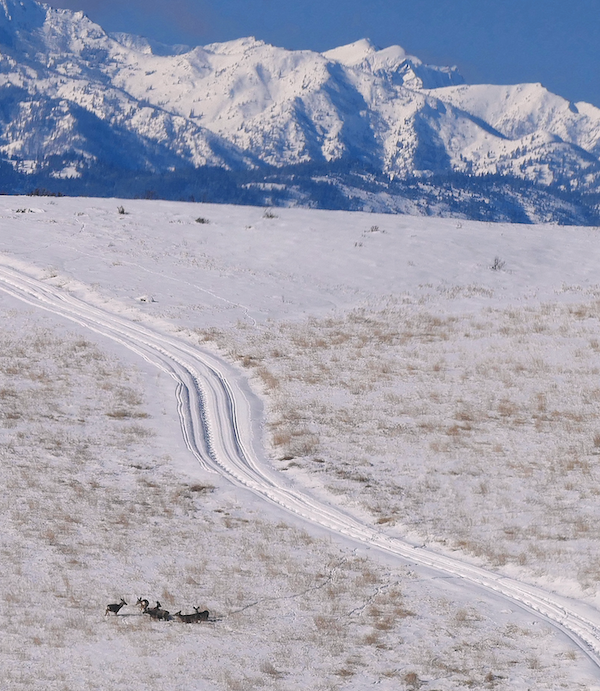
Beau Patterson, a former WDFW district wildlife biologist who now works for a local utility, called it the “worst conditions I’ve seen for wintering deer” in his 22 years in the Wenatchee Valley.
The area saw from 2 feet of snow in 24 hours in Wenatchee to an incredible 4 feet in 48 hours upvalley in Leavenworth, and then freezing rain formed a glaze on top of the snow in some areas.
“It may not chalk up as a severe winter overall, but right now we’ve got deep, heavily crusted snow on the winter ranges, and too-deep snow at elevations above the crust,” said Patterson on Saturday morning. “These conditions can kill a lot of deer fast, even if things moderate fairly quickly.”
This morning a Leavenworth resident reported the snow has since settled there to about 3 feet but noted the forecast calls for sleet and freezing rain. They also said that hillsides with south-facing aspects near Wenatchee had less snow but numerous deer trails and they hoped the herd had moved to those areas and found browse.
That would be plants like ceanothus and bitterbrush.
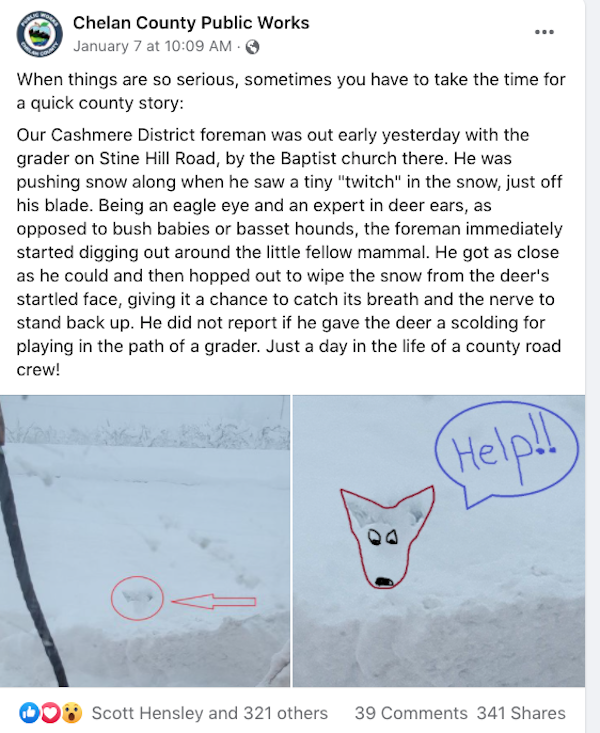
Emily Jeffreys, WDFW’s current Chelan-Douglas County district wildlife biologist, yesterday said she understood and appreciated that the heavy snowfall had folks worried about the region’s deer and how it was impacting the animals’ movements across the landscape.
“However, I don’t believe we have reason to fear for Chelan County’s mule deer population yet. Winter actually started pretty late and deer experienced relatively mild conditions on winter range until temperatures dropped in late December. Further, last week’s extreme snow event occurred early enough in the season that deer should still have considerable fat stores. Although Chelan County experienced wildfires this past summer and fall, these fires were not extensive enough to have compromised deer’s ability to find adequate forage and put on weight while on summer range as well as during fall greenup,” Jeffreys stated.
One of the fires, Red Apple, burned across range just northwest of Wenatchee, while the Twenty-five Mile blaze was further into the backcountry.
“Mule deer are well-adapted to survive harsh winter conditions, and one heavy snowfall, although unusually extreme, still isn’t enough to warrant concern about the possibility of poor fawn recruitment or winter kill at this juncture,” Jeffreys stated. “Fawn recruitment may well be down this year compared to that following the relatively mild 2020/2021 winter, but I think it’s too soon to come to the conclusion that deer in Chelan County are in ‘dire straits.'”
The National Weather Service’s Climate Prediction Center 8-14-day outlook does call for stronger odds of slightly warmer and more normal precipitation through January 24th, but there’s also still plenty of winter to come.
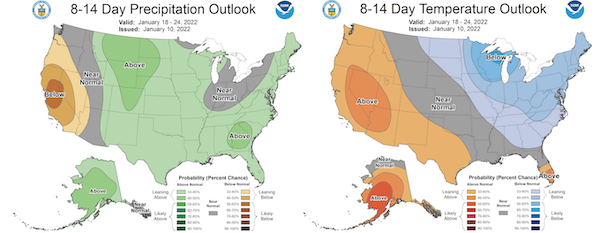
“If severe winter conditions such as unusually heavy snow, icing/crusting of snow, and extreme cold or wind continue over a prolonged period, the short-term outlook for our mule deer population will become more troubling,” Jeffreys acknowledged.
In the next district to the north, WDFW’s Scott Fitkin echoed Jeffreys, albeit with a couple caveats.
“We had more deer summer range affected by fire which may have affected body condition a bit for some animals,” he noted of the Cub Creek 2, Cedar Creek and Muckamuck Fires.
“There’s also more snow in much of the Methow than in the Okanogan Valley or the lower portions of the Wenatchee Valley, but that’s generally always the case,” Fitkin added. “Bottom line, my guess is that fawn mortality may be a bit higher than average this winter, but at this point I don’t anticipate extreme numbers. Regardless, our only constructive course of action will be to monitor the situation and adjust our future management activities accordingly to mitigate should it be necessary. Such are the vagaries of nature.”
Even as some think feeding the deer will help them, biologists strongly and consistently argue against it, saying it “can lead to unforeseen problems and can actually do more harm than good” as the animals’ digestive systems can’t deal with a suddenly changed diet and which can result in bloating and even death for some. Think of it like you switching to grazing your front yard because Safeway’s all out of stuff and how well that would work out for you.
“On the plus side, hopefully all this moisture will translate into fuller ponds and lakes this summer and a reduced chance for additional EHD/bluetongue outbreaks. It should also make for a good summer season for does to achieve recovery weight gain,” Fitkin added.
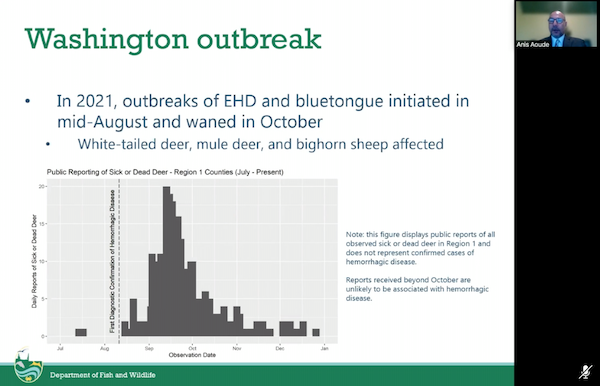
Speaking of those disease outbreaks, a Sunday article in the Spokane Spokesman-Review provided more details on losses in Northeast and Southeast Washington deer herds. Reporter Eli Francovich wrote that 25 percent of collared whitetails in Ferry, Stevens and Pend Oreille Counties died from EHD and bluetongue, while 15 percent of collared mule deer does in Walla Walla, Columbia, Garfield and Asotin Counties were lost.
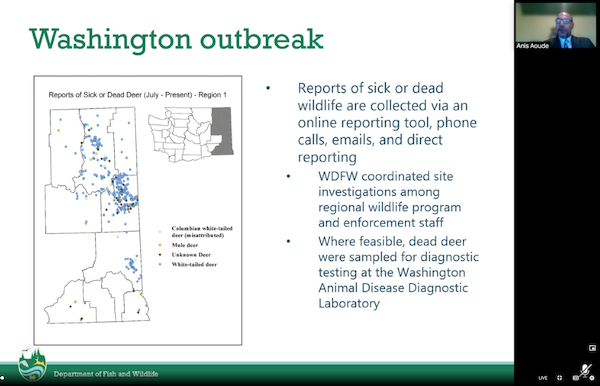
Elk calves and bighorn sheep were also affected.
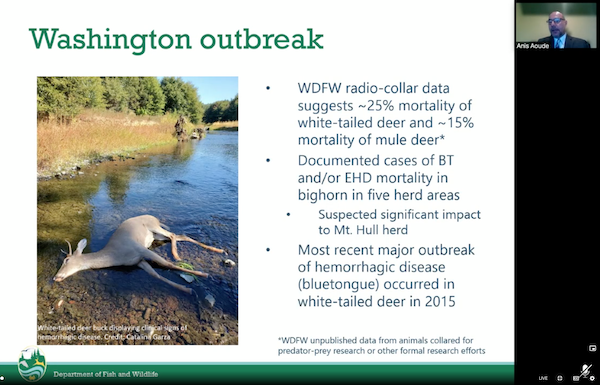
The outbreak is the subject of a WDFW briefing of the state Senate’s Agriculture, Water, Natural Resources & Parks Committee today. Game Division manager Anis Aoude told lawmakers the agency would be proposing a “significant reduction of antlerless” special permits and a “reduction” of buck permits for the 2022 season, but that general seasons are “unlikely to be impacted or curtailed in the future,” though clearly there will be fewer whitetails on the landscape in Northeast Washington this fall.
Spokane-based WDFW district wildlife biologist Michael Atamian also provided Eli with some advice for limiting disturbance of wintering big game herds: keep your dogs on leashes and stick to established winter trails when recreating on wildlife areas.
Indeed, after spotting what looked like signs of a snowmobile pursuing deer in the Wenatchee area, perhaps to shake off bucks’ antlers, Patterson, the former state biologist, added another tip in a Facebook post: “AND DONT @$#%@$@ chase them.”
Except he didn’t use a bunch of symbols.
